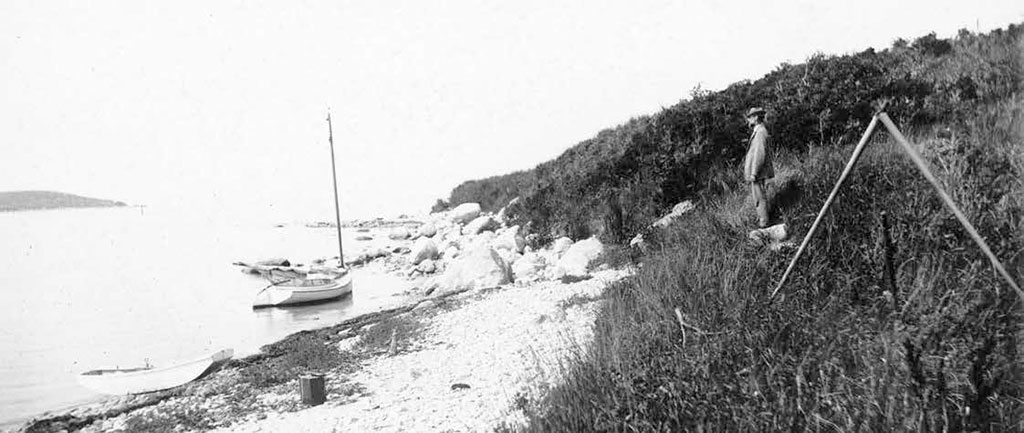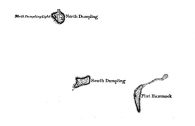
Man standing on south shore of South Dumpling Island, Fishers Island Sound, 1895. Photo by James S. Casey.
by Robert P. Anderson, Jr.
My earliest memory of the name South Dumpling Island, almost 70 years ago, was hearing my father Robert P. Anderson entertain guests in the main cabin of our ketch Kestrel with stories of the olden days in Noank. From my bunk in the fo’c’sle I shuddered at his description of the wreck of the great steamship Atlantic on November 27, 1846 at North Hill, Fishers Island, just south of South Dumpling. Nearly fifty souls died in the frigid water that night. One of the victims was a Belgian lace merchant, whose cargo in barrels washed up on the shore, eagerly picked up by boats of Noank scavengers and the lace distributed among Noank homes. My grandmother still treasured hers.
My father loved telling about his early job as mate for the Noank lobsterman Wayland Morgan, whose pots were set near South Dumpling. One day Wayland received some very bad news: the New York Fish & Game Commission decreed that every boat fishing in New York waters would be required to have a name. He’d been lobstering there for a good many years, and his boat had never had a name, and he was darned if he was going to obey this highhanded order. Eventually, though, he decided he had better comply. So on the very last day for registration Wayland went to the Suffolk County office and entered the shortest name he could think of, It.
Over the years the waters around South Dumpling became a favorite destination of our boat. Sailing to and from Noank required crossing the strong tidal currents of Fishers Island Sound, either flood or ebb, and a light wind made the trip challenging and uncertain.
While courting my wife Mary in Minneapolis, Minnesota during the late 1950s, I discovered a print of North and South Dumpling islands in a most unlikely place: the back of playing cards from United Airlines. The painting was by Y.E. Soderberg, whom I knew, and it represented for me the charm of my homeland in which I was hoping to interest Mary.
During the two years 1962-64 Alfred L. Ferguson, III served as law clerk to my father in his last year as Chief Judge of the U.S. District Court for the District of Connecticut. Since his Second World War years in southern England, my father had wholeheartedly adopted the custom of afternoon tea, where an informal familiarity existed among the judge, his law clerk and his secretary. At one of these daily events in 1963, Al Ferguson, knowing of my father’s lifelong residence in Noank, mentioned casually that his grandfather Alfred L. Ferguson was going to sell South Dumpling Island. Instantly Pa responded, “I’ll buy it!”
The record owner of the island was the West End Land Company, Inc., a New York domestic corporation of which Alfred L. Ferguson was the President. In due course, a bargain and sale deed executed on February 20, 1964 was delivered by Mr. Ferguson, Sr. to my father and subsequently recorded in the Suffolk County Land Records at book 5507, Page 584. A $2.20 documentary stamp disclosed the $2,000 sale price.
Our family used South Dumpling for occasional picnics but no overnights. My father would anchor our sailboat about half way to Flat Hammock Island, and from there we rowed to South Dumpling. My father periodically spoke of having a wharf built on the east side of the island to facilitate tying up his boat there, but fortunately nothing ever came of it. I was concerned about inevitable vandalism and favored leaving the island as it was.
As the years passed, the habitats for gulls, terns, cormorants, egrets and other waterfowl became increasingly “developed” for human habitation, and the remaining nesting sites at places like South Dumpling were concentrated into fewer and fewer natural areas. The resulting intensification of roosts for birds began to be evident as their droppings changed the soil chemistry beneath the trees. Quite rapidly the trees died, until now (2016) no large trees remain on South Dumpling. In roped-off grids on the west side of the island, the staff of Project Oceanology in Groton observed and recorded what was happening.
On May 2, 1978 my father died residing in Groton, and in due course my brother Frederic and I were appointed Co-Executors of his will. Although South Dumpling passed to us through his estate, we could not dispose of it until we satisfied the New York Estate Tax and completed ancillary probate through the Surrogate’s Court of Suffolk County. At that time the island’s value was appraised at $11,900.00. The tax department’s questions about the island’s residents were answered, “water rats and seagulls”, and about its plants, “bayberry, rosa rugosa, sumac and poison ivy.”
Being used to the helpful, courteous personnel in the Connecticut probate courts, I was in for an unpleasant surprise. In addition to incomplete instructions, necessary forms withheld and nonsensical procedures, I had to disavow my profession as a Connecticut lawyer before they would allow me to settle my father’s estate. I became so exasperated with New York bureaucrats I resolved to give the island away and spare my children from having to deal with such people. My brother agreed.
The Mashantucket Land Trust, comprising the Towns of Groton, Ledyard, Stonington and North Stonington, was our natural choice for a donee. The environmental movement was gaining strength, and I was aware of instances when organizations seeking to protect the natural environment were denied standing in court because of not having a pecuniary interest in the subject of the litigation. If Mashantucket were to own South Dumpling, no one could claim it lacked a pecuniary interest to protect.
At this time there was a very powerful urban planner in New York named Robert Moses. Notorious for pushing the construction of highways, bridges and tunnels, he was seen as a dangerous enemy of conservationists. In truth his guiding philosophy seemed to be that if any project were possible to do, it should be attempted. From the mid-1960s through the 1970s, he vigorously promoted the idea of a cross-sound bridge—most prominently one that linked Oyster Bay to Rye. Each of his proposals was thwarted by political and citizen opposition. In 1979, the prospect of a cross-sound bridge surfaced again. One of the proposed routes would spare Long Island drivers the bottleneck in New York City by building a giant causeway from Orient Point, Long Island that bisected the west end of Fishers Island and neighboring South Dumpling before traversing northward to the vicinity of Groton Long Point. Ownership of South Dumpling by the Mashantucket Land Trust would certainly “jam a stick in the spoke” of that project, and so we proposed a gift to the land trust.
However, before Mashantucket could accept South Dumpling, its certificate of incorporation had to be amended to allow it to acquire and hold land outside of Connecticut. This was accomplished in the spring of 1979.
On May 29, 1979 ancillary probate of my father’s estate and payment of the New York Estate Tax ($194.19) were completed, and full title to the island passed to my brother and me.
We conveyed South Dumpling to the Mashantucket Land Trust, Inc. by a quit-claim deed dated November 30, 1980 and recorded in the Suffolk County Land Records at Book 9036, Page 379.
As a postscript not connected with the island, on June 6, 1995 the land trust formally changed its name to Avalonia Land Conservancy, Inc. as it presently is known. South Dumpling continues offering a habitation for waterfowl, despite the absence of trees, and remains a favorite destination of our Noank Sloop, Winsome.
Robert ”Chip” Anderson, an attorney at the law firm of Waller, Smith & Palmer, New London, Conn., is a life-long resident of Noank, Conn. He maintains and sails an engineless wooden Noank Sloop.



